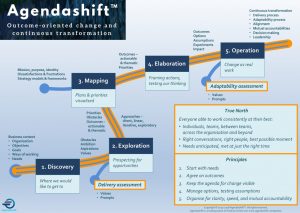 I first blogged about my early thoughts on Strategy Deployment and Agendashift nearly two years ago after some early experiments with Mike Burrows’ approach. Since then I’ve learned more, become an Agendashift partner, and co-taught a couple of “Lean-Agile Strategy Days” with Mike in June and October last year.
I first blogged about my early thoughts on Strategy Deployment and Agendashift nearly two years ago after some early experiments with Mike Burrows’ approach. Since then I’ve learned more, become an Agendashift partner, and co-taught a couple of “Lean-Agile Strategy Days” with Mike in June and October last year.
More recently I used some of the elements of Agendashift during an X-Matrix workshop at Agile Gurugram. This is an overview of how I currently see the various pieces fitting together from the perspective of the Agendashift workshop sections: Discovery, Exploration, Mapping, Elaboration, Operation.
Note that this assumes some familiarity with both Agendashift and the X-Matrix.
Discovery – Where would we like to get to
There are two primary exercises: Celebration and FOTO (From Obstacles To Outcomes). The output of Celebration can be thought of as a True North – the higher intent which is guiding the change. Note that this is not to be confused with Mike’s own Agendashift True North. From that, the outcomes which result from of FOTO, and in particular the longer term ones, can be used to identify the X-Matrix Aspirations.
Exploration – Prospecting for opportunities
The Agendashift unbenchmarking report, which is generated from participants assessments can be considered a form of diagnosis (as per Rumelt’s Strategy Kernel of Diagnosis, Guiding Policies and Coherent Action). It helps the participants identify the critical challenges or opportunities for change. Thus the 2nd round of FOTO along with the subsequent Cynefin Four Points Contextualisation exercise, can be used as a way of identifying the X-Matrix Strategies by naming the important clusters and themes that emerge.
Mapping – Plans and priorities visualised
In the context of Agendashift, the X-Matrix can be considered to be an alternative to transformation map which is typically created. However, the exercise used here known as POWT (Prompts, Obstacles, What would you like to have happen, Then what happens) is still useful as a means of identifying X-Matrix Evidence. The granular outcomes generated can feed into ODIM (Outcomes, Decisions, Insights, Metrics) to convert them to items which can be used to indicate progress (or otherwise).
Elaboration – Framing actions, testing our thinking
At this point, the options for change being generated are X-Matrix Tactics. Instead of diving down straight into the details of Experiment A3s, an alternative is to use Backbriefing A3s as a way of maintaining coherence and grouping options together with similar intents. Also at this point we can complete the X-Matrix correlations (or contributions as I’m increasingly calling them) which is another way of testing that there is sufficiently messy coherence.
Operation – Change as real work
Finally, we have a populated X-Matrix and the Agendashift tools become part of the Strategy Deployment Catchball process to further encourage participation in, and consensus on, the continuing work of transformation.
The Agile Gurugram experiment of more tightly integrating the elements of Agendashift with the X-Matrix was successful enough to encourage me to look for more opportunities to explore the synergies further. One such opportunity will be a 3 day Agendashift + X-Matrix Masterclass with Mike in Brighton, October 9-11 (just before the Lean Agile Brighton conference on October 12). Tickets are now on sale, with limited early bird places!
And if you’re like me to run an Agendashift X-Matrix workshop with your organisation, please get in touch.
